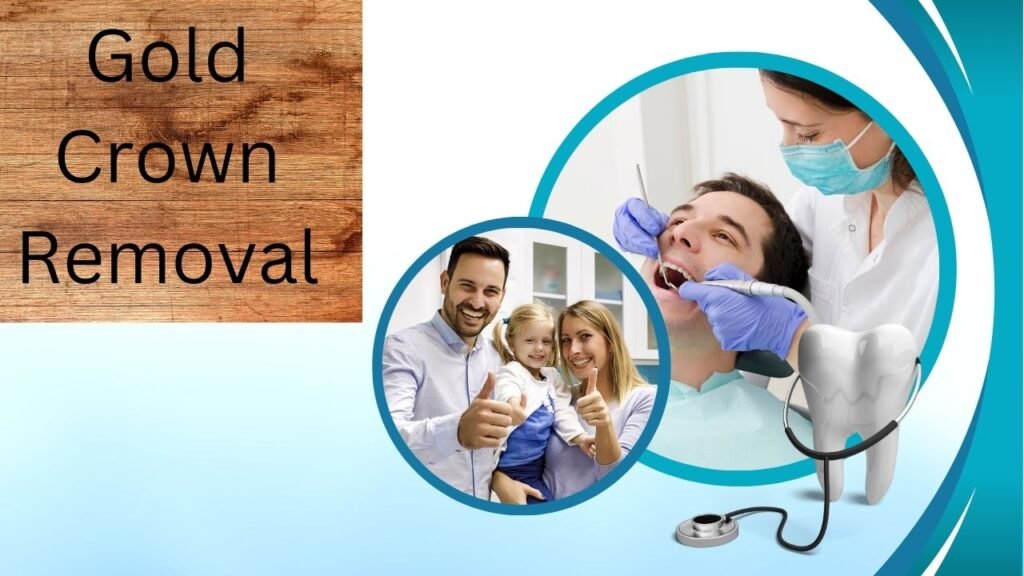Gold crowns are highly durable dental restorations that can last for many years. However, there are times when they need to be removed—whether due to damage, decay, or a desire for a new crown. This guide will walk you through the entire gold crown removal process, answering common questions and addressing user concerns.
If you’re facing this procedure or just curious, this article provides a clear, step-by-step explanation to help you understand what to expect.
Why Would a Dentist Remove a Gold Crown?

Before diving into the removal process, it’s essential to understand why a gold crown might need to be removed. Here are the main reasons:
- Replacement of a Loose or Broken Crown: Over time, a crown can become loose or damaged, necessitating replacement.
- Decay Under the Crown: Decay can occur beneath the crown, which needs to be addressed to maintain oral health.
- Aesthetic Upgrades: Some patients opt for crowns that look more natural, replacing gold crowns with materials like porcelain.
What to Expect During the Gold Crown Removal Procedure
Removing a gold crown involves several precise steps. Here’s a detailed breakdown of what happens during the procedure:
1. Preparation: Ensuring a Comfortable Experience
Before any removal begins, the dentist will prepare the area to ensure minimal discomfort:
- Local Anesthetic: The dentist administers a local anesthetic to numb the area around the tooth. This numbing agent ensures that you don’t feel pain during the procedure, though you might still feel some pressure.
- Assessing the Crown: The dentist will evaluate the condition of the crown and the surrounding tooth to determine the best approach for removal.
2. Weakening the Cement: Loosening the Crown
Gold crowns are secured with a strong dental cement. To remove the crown, the cement needs to be loosened:
- Ultrasonic Vibrations: Dentists often use ultrasonic tools that emit vibrations to help break down the cement without damaging the tooth.
- Chemical Agents: Sometimes, a chemical agent is applied to dissolve the cement, making the crown easier to remove.
3. Removal Techniques: The Main Methods
The dentist will use specific techniques to remove the crown:
Standard Technique: Using a Dental Drill
- Creating a Groove: The dentist drills a small groove or slot in the crown. This allows access to specialized tools.
- Loosening the Crown: Instruments like crown removers or splitters are used to carefully pry the crown off. You may hear the sound of the drill during this process, but the numbing medication ensures that this sound is the main sensation, not pain.
Preserving the Crown: Laser and Alternative Tools
- Laser Removal: If the crown needs to be preserved for reuse, a laser can precisely target the cement to gently separate the crown from the tooth.
- Specialized Tools: Other tools may be used to ensure the crown remains intact if it’s to be reused.
4. Cleaning and Evaluation: Preparing for Next Steps
Once the crown is removed:
- Cleaning the Tooth: The dentist thoroughly cleans the tooth to remove any residual cement and debris.
- Assessing the Tooth: The dentist examines the tooth for decay or damage. If any issues are found, further treatment may be necessary.
Possible Additional Procedures
In some cases, additional procedures may be required after crown removal:
Root Canal: Treating Underlying Decay
- Procedure: If decay is present, a root canal may be necessary to remove infected pulp from inside the tooth.
- Purpose: This procedure helps save the tooth from further damage.
New Crown: Restoring the Tooth
- Material Options: After treatment, a new crown is typically fitted. Modern crowns can be made from porcelain or zirconia for a natural appearance.
- Process: Impressions of the tooth are taken to ensure the new crown fits perfectly, and a temporary crown may be placed while the permanent one is made.
Post-Procedure Care
After crown removal, following proper care instructions is crucial for maintaining oral health:
- Oral Hygiene: Continue to brush and floss regularly. Your dentist will provide specific care instructions to aid healing and prevent issues.
- Follow-Up Appointments: Schedule follow-up visits as recommended to ensure everything is healing correctly.
Benefits of Removing a Gold Crown
Despite their robustness, there are several valid reasons for removing a gold crown:
- Repair or Replacement: A damaged or loose crown requires replacement to restore function.
- Decay Treatment: Removing the crown allows for treatment of decay underneath.
- Aesthetic Preferences: Upgrading to a more natural-looking crown material can improve your smile’s appearance.
Conclusion
Removing a gold crown is a standard dental procedure that, when performed by an experienced dentist, involves minimal discomfort and effective outcomes. Whether you’re dealing with a loose crown, underlying decay, or simply want to update your crown, understanding the process can help you feel more prepared.
If you have concerns about your gold crown or need further information, scheduling a consultation with your dentist is a proactive step towards maintaining your oral health.
Find Your Perfect Dentist
Book appointments with top-rated dentists in your area